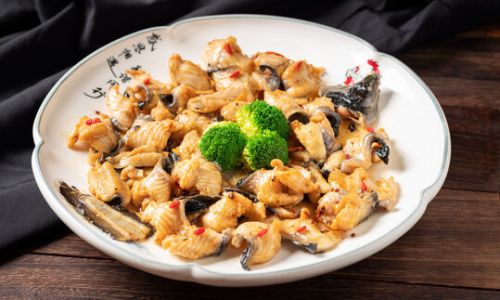Introduction
Steamed eel with black bean sauce, or Chǎi Zhī Zhēng Bái Shàn in Cantonese cuisine, is a dish that epitomizes the delicate balance of umami-rich flavors and tender textures. This culinary masterpiece, rooted in Guangdong province’s gastronomic heritage, combines the silky richness of freshwater eel with the savory depth of fermented black beans, ginger, and garlic. While the recipe may appear deceptively simple, achieving perfection requires precision in ingredient selection, meticulous preparation, and an understanding of steam-cooking techniques. This article will demystify the process, offering a step-by-step breakdown to recreate this iconic dish in your kitchen.
Understanding the Star Ingredient: Freshwater Eel
The foundation of this dish lies in selecting the right eel. Freshwater eel, scientifically known as Anguilla japonica, is prized for its tender flesh and mild sweetness. When purchasing, look for specimens with glossy skin, clear eyes, and a minimal fishy aroma. If fresh eel is unavailable, frozen options can suffice, but ensure they are thoroughly thawed and patted dry before cooking.
Preparing eel requires care. Unlike firm-fleshed fish, eel’s slippery texture and delicate bones demand a specific approach. Begin by scaling the eel under cold running water, using a spoon or knife to gently scrape against the grain. Next, remove the slimy mucus layer—a critical step to eliminate any earthy aftertaste. Some chefs recommend blanching the eel briefly in boiling water or rubbing it with coarse salt before rinsing.
The Anatomy of Black Bean Sauce
Central to this dish’s character is the black bean sauce (dòu chǐ). Fermented black beans, salted and aged in clay pots, deliver a salty, funky complexity that elevates the eel’s natural flavor. To prepare the sauce:
- Rinse 2 tablespoons of fermented black beans under cold water to remove excess salt.
- Mash them coarsely using a mortar and pestle or the flat side of a cleaver.
- Combine with 1 tablespoon each of minced garlic, ginger, and shallots.
- Add 1 teaspoon of sugar, 1 tablespoon of Shaoxing wine, and 2 tablespoons of oyster sauce.
- Stir in 1 tablespoon of sesame oil and a pinch of white pepper.
This mixture forms the flavor base. For added richness, some recipes incorporate fermented bean curd (fǔ rǔ) or dried shrimp, but the classic version relies on the interplay of black beans and aromatics.

Marinating the Eel: Locking in Flavor
Marination serves dual purposes: tenderizing the flesh and infusing it with aromatic notes. After cleaning and cutting the eel into 2-inch segments, marinate it for 20–30 minutes in a mixture of:
- 1 tablespoon light soy sauce
- 1 teaspoon dark soy sauce (for color)
- 1 tablespoon cornstarch (to seal in juices)
- 1 tablespoon Shaoxing wine
- 1 teaspoon sugar
Gently massage the marinade into the eel pieces, ensuring even coating. Avoid over-marinating, as the soy sauce’s saltiness can toughen the flesh if left too long.
Assembling the Dish: Layering Flavors
The presentation of steamed eel is as crucial as its taste. Traditional recipes arrange the eel segments in a circular pattern on a heatproof plate, skin-side down, to prevent curling during cooking. Nestle slices of ginger and scallion whites beneath and between the eel pieces to impart fragrance.
Spoon the black bean sauce generously over the eel, ensuring each piece is coated. Reserve a small portion of the sauce to drizzle post-steaming for added luster. Some variations add thinly sliced red chilies or bell peppers for color, though purists prefer the minimalist approach.
The Science of Steaming: Mastering Heat and Timing
Steaming is a gentle cooking method that preserves the eel’s texture while melding flavors. Use a bamboo steamer or a wok with a rack, ensuring the water level remains below the steaming basket to prevent sogginess. Bring the water to a rolling boil before lowering the heat to maintain a steady simmer.
Steam the eel for 8–10 minutes, depending on thickness. Overcooking risks drying out the flesh, while undercooking leaves it rubbery. To test doneness, insert a chopstick into the thickest segment—it should glide through with minimal resistance.
Finishing Touches: Glazing and Garnishing
Upon removing the eel from the steamer, discard any accumulated liquid (which can be bitter). Heat 2 tablespoons of peanut oil in a small saucepan until shimmering, then drizzle it over the eel to activate the aromatics and create a glossy sheen.
Garnish with fresh cilantro sprigs, julienned ginger, and thinly sliced scallion greens. For an optional flourish, sprinkle toasted sesame seeds or fried shallots for crunch.

Serving Suggestions and Pairings
Steamed eel with black bean sauce pairs beautifully with steamed jasmine rice, which absorbs the sauce’s savory juices. Complementary sides include stir-fried bok choy with garlic or a light soy-ginger broccoli. For beverages, serve chilled jasmine tea or a crisp Riesling to balance the dish’s richness.
Troubleshooting Common Pitfalls
- Fishy Aftertaste: Ensure thorough cleaning and blanching. Avoid eel with cloudy eyes or a strong ammonia smell.
- Dry Texture: Marinate with cornstarch and avoid oversteaming. Check doneness early.
- Bitter Sauce: Rinse fermented black beans well and discard any grit.
- Uneven Cooking: Arrange eel in a single layer; avoid overcrowding the steamer.
Variations and Modern Twists
While tradition demands respect, contemporary chefs experiment with adaptations:
- Spicy Black Bean Sauce: Add minced Thai bird’s eye chilies or Sichuan peppercorns.
- Citrus Zest: Incorporate lime zest or yuzu juice for brightness.
- Mushroom Infusion: Layer shiitake or enoki mushrooms beneath the eel.
Cultural Significance and Health Benefits
Beyond its culinary appeal, this dish holds cultural weight. In Cantonese culture, eel symbolizes prosperity and resilience, often served during festivals. Nutritionally, eel is rich in omega-3 fatty acids, vitamin A, and protein, while fermented black beans aid digestion and provide probiotics.
Conclusion
Steamed eel with black bean sauce is a testament to the elegance of Chinese steam-cooking techniques. By mastering ingredient selection, meticulous preparation, and precise execution, even novice cooks can replicate this restaurant-quality dish at home. The interplay of textures—silken eel, aromatic sauce, and crisp garnishes—creates a symphony of flavors that honors tradition while inviting creativity. Whether for a family feast or a solo indulgence, this dish promises a culinary journey worth savoring.
Final Tips for Success
- Use a sharp knife to cut eel segments cleanly, minimizing flesh damage.
- Invest in a high-quality bamboo steamer for even heat distribution.
- Adjust seasoning to taste—some prefer a sweeter sauce, while others lean into saltiness.
With patience and practice, this recipe will become a cherished addition to your repertoire, bridging generations through the timeless language of food.






0 comments